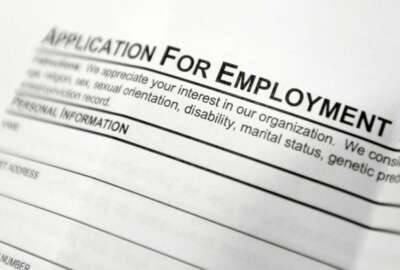How will OPM’s ‘rule of many’ function in federal hiring?
The “rule of many” proposal from OPM aims to combine two previous hiring systems — the “rule of three” and “category rating” — while addressing more...
Federal hiring managers will soon have several new options to use when putting together a qualified list of job applicants.
The Office of Personnel Management first published proposed regulations in July to offer a different method for narrowing down federal job applicants. That method, called the “rule of many,” aims to give hiring managers more flexibility.
Specifically, the “rule of many” will eventually let hiring managers, prior to posting a job announcement, determine from several different options how they’ll score and rank applicants for an open position. That includes specifying how many of those applicants will end up on their final list of qualified candidates.
The proposal from OPM, at least to some extent, combines two previous systems — the “rule of three” and “category rating” — that agencies have used over the years to determine lists of qualified candidates.
The first system, the now-defunct “rule of three,” was first established back in 1871. Many agencies used it for much of the 20th — and partly into the 21st — century.
Under the “rule of three,” agencies would evaluate, score and rank candidates based on criteria that were determined to make applicants qualified for a given job opening. By the end of the process, agencies would produce a list of candidates based on those rankings. But the catch was that agencies could only select one of the top three candidates to actually make an offer to.
The “rule of three” was limiting in many cases, said Jenny Mattingley, vice president of government affairs at the Partnership for Public Service. The system could exclude potentially qualified candidates if they weren’t one of the top three options. And it often led to agencies having to restart the whole recruitment process, if none of the top three candidates fit the desired qualifications or ultimately accepted a job offer.
“That doesn’t give you a lot of flexibility, especially if you’re hiring for multiple positions,” Mattingley said in an interview.
Back in 1995, the Merit Systems Protection Board said the “rule of three” was outdated and called for its elimination.
“The rule of three in federal hiring is even older than the U.S. Civil Service,” MSPB said in a December 1995 report. “Given the limitations of current examining processes, the rule of three remains valuable only as a ‘floor’ to ensure that managers have choices — which was its original purpose. As a curb on the number of candidates referred to managers, it does not represent good hiring policy.”
Although agencies largely stopped using the “rule of three” around the turn of the 21st century, the hiring method was only completely eliminated from law with the passage of the fiscal 2019 National Defense Authorization Act (NDAA).
By 2010, agencies were already largely shifting to a different selection method, called the “category rating” system. It places job applicants into three categories of qualifications, such as good, better and best fit for the job.
Under the “category rating” system, for example, candidates who have many — but not all — of the desired attributes for a job opening could be labeled as “qualified,” while candidates who have all of the desired traits could be considered “highly qualified.” Agencies can then select a chosen applicant, incorporating veterans’ preference, from the highest category of candidates.
“You might have 10 candidates, 20 candidates or more, depending on the criteria in your best qualified category,” Mattingley said. “It gives agencies an opportunity to consider a lot more applicants at one time.”
But the “category rating” process doesn’t fully encompass how federal hiring functions currently, and at times it can produce a list of candidates that’s almost too big to manage, some federal hiring experts have said.
Now, OPM’s goal of the “rule of many” is to let hiring managers look at a larger list of qualified candidates than the “rule of three” allowed for, but at the same time, tailor the process more specifically than what may be possible in “category rating.”
OPM’s proposal is somewhat of an in-between of the two older systems, Mattingley said.
“With the ‘rule of many,’ it’s not three, and it’s not the bigger pool that you see in category rating,” Mattingley said. “OPM has a couple of different options to cut it, but you’re picking some smaller number of candidates that you’re going to consider as your top-ranked candidates for whatever that hiring action is.”
The new system also aims to reflect evolving challenges in the broader hiring landscape, said Mike Mahoney, a hiring policy manager at OPM.
“The challenges [in recruitment] are immensely different, more varied and more complex,” Mahoney said in an interview. “A lot of different positions are evolving in ways that have never really been seen before. So, we started to look into, ‘maybe we need to get back to that [rule of three] somehow, but not be constrained by having only three people to pick from.’”
The “rule of many” is the result of a provision of the 2019 NDAA, which required OPM to set up a new system for scoring and ranking federal job applicants.
Specifically, the 2019 NDAA authorized agencies to certify a ‘sufficient number’ of at least three — but probably more — names from a list of eligible candidates to be considered for selection.
Based on that language, in its proposed regulations, OPM opted to create four new choices for hiring managers when selecting their method to create a list of qualified job candidates.
The four options under the “rule of many” are:
- Set a cut-off score, where any applicant who scores above it can be considered for a job offer
- Set a cut-off score, where any applicant who scores above it can be considered for an interview
- Set a specific number of higher-ranked candidates who can be considered for a job
- Set a specific percentage of higher-ranked candidates who can be considered for a job
Generally, agencies can determine applicants’ scores based on the criteria they feel are necessary for the given position. That process can involve other more recent hiring practices in government, such as the use of subject-matter experts (SMEs) or technical assessments.
“Agencies will probably need experts involved in some of that to determine, ‘what are the skills and qualifications? And what are the types of assessments that would help you identify those skills?’” Mattingley said.
Ultimately, the goal of the “rule of many” is all about giving hiring managers more flexibility.
“The ‘rule of many’ combines the best aspects of the ‘rule of three’ process, with the best aspects of ‘category rating,’” Mahoney said. “It accounts for the meaningful numerical distinctions among applicants, but it gives managers more choices to pick from.”
Of course, veterans’ preference still applies, and agencies are still bound to merit system principles throughout the recruitment process.
OPM closed the comment period for the “rule of many” proposed regulations on Sept. 19. The agency is now working through comments and plans to issue final regulations in the coming months.
Copyright © 2025 Federal News Network. All rights reserved. This website is not intended for users located within the European Economic Area.
Drew Friedman is a workforce, pay and benefits reporter for Federal News Network.
Follow @dfriedmanWFED






